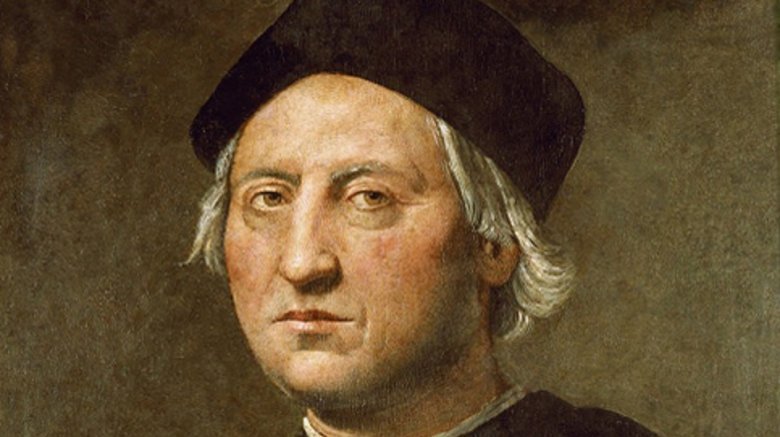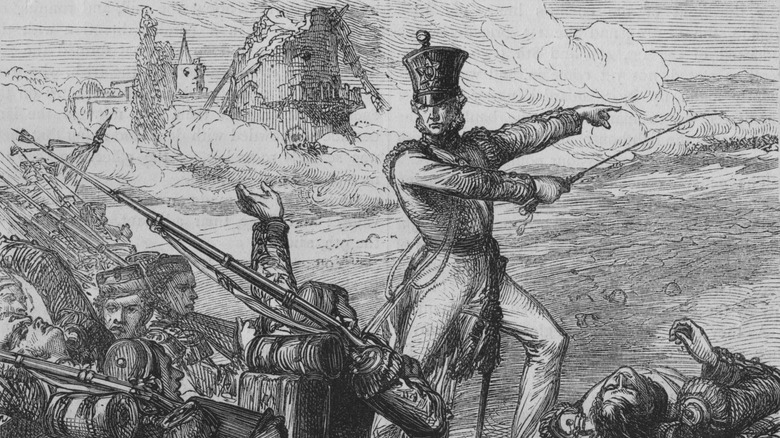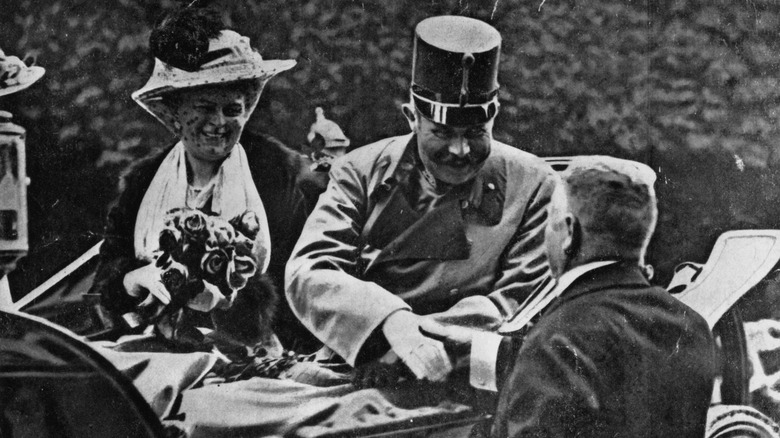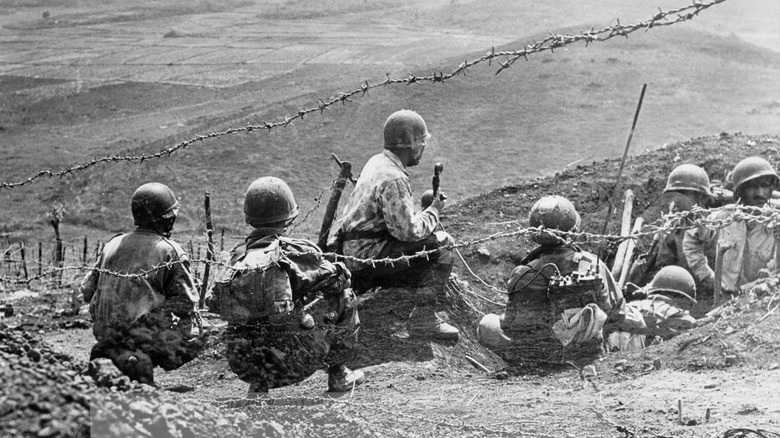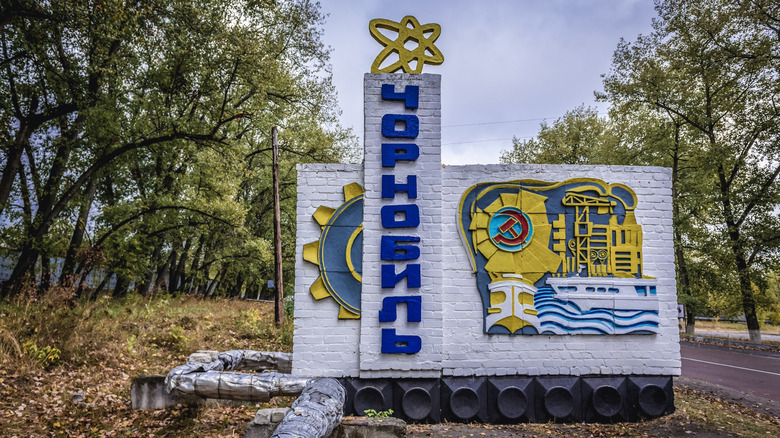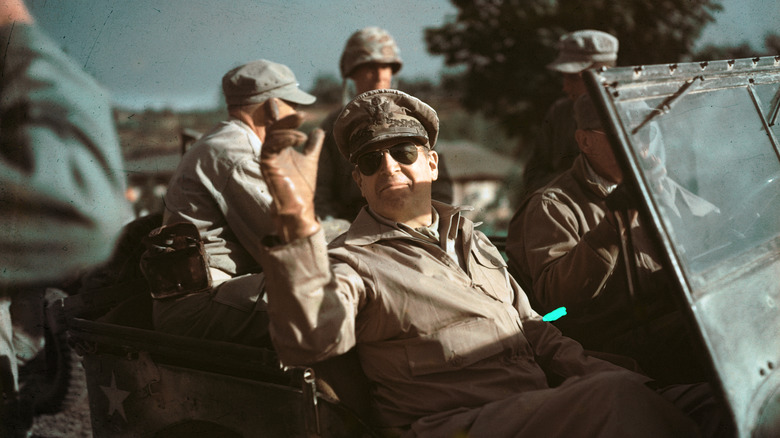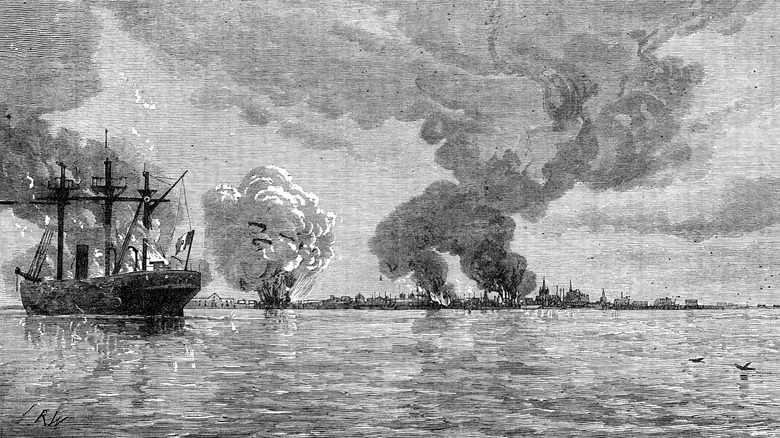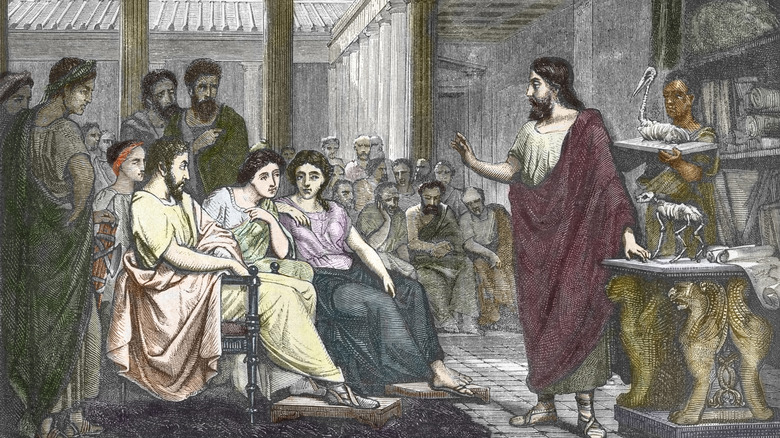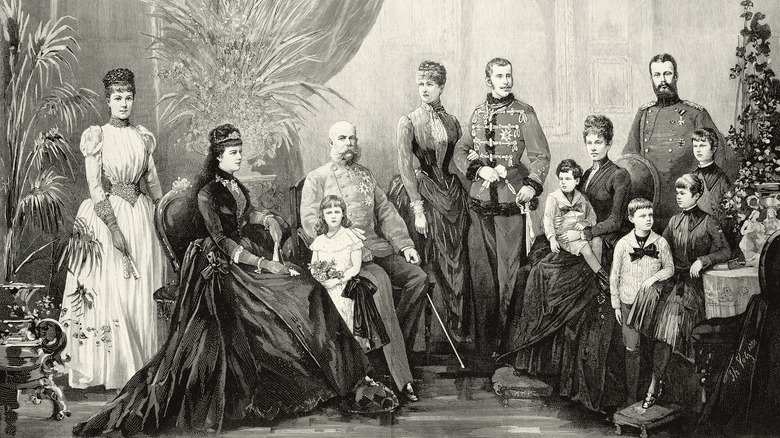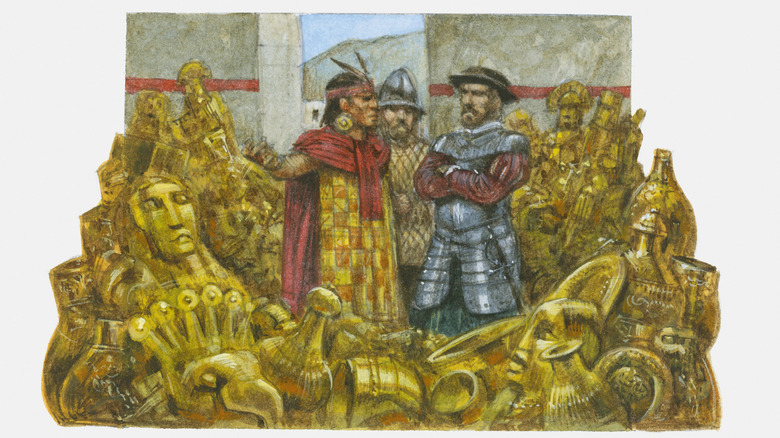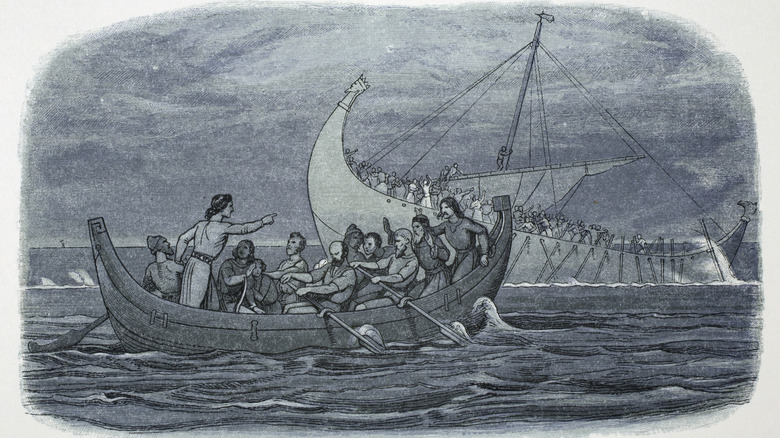Idiot Mistakes That Changed The Course Of History
We've all been there. We've all felt the slow burn of realization that comes when it finally becomes clear we've done something horribly wrong. Take solace in this: Whatever you did, you probably didn't change history for anyone but yourself.
These people changed the world on a grand scale, so large that it's still felt today. They changed the fate of entire nations, started a chain reaction that led to countless deaths, and sometimes, their mistakes led to centuries of persecution and racial hatred.
But there's a bright side here, too. Sometimes, history didn't change for the worse; it changed for the better. The important thing about mistakes is that we learn from them, and sometimes, it takes a big one for humans to sit up, take notice, and say, "Hang on a sec ... we can fix this." And we do, occasionally, dust our collective selves off, push up our sleeves, and get fixing. That's as inspirational as you'll find in human history.
The bad planning of Louis XVI and Marie Antoinette
The French Revolution was a bloody period in France's past where unrest led to a lot of practice with a guillotine. King Louis XVI took a final trip there in 1793, Marie Antoinette followed a few months later, and France changed forever.
Their deaths kicked off the Reign of Terror and led to thousands of executions and the rise of Napoleon. But here's the thing — they didn't need to die at all, and probably wouldn't have if Louis XVI hadn't made a whole series of dumb decisions.
It started when thousands of people stormed the Bastille in July 1789 for weapons. In October, they captured the royals and escorted them to the Tuileries. But here's the important part — they weren't locked up. Louis and Marie Antoinette both could have walked out the door any time, but they didn't. It wasn't until around two years later that they finally snuck out, but they planned their escape pretty impractically.
They traveled together in a large, conspicuous wagon laden with things like a complete dinner service and wine chest, and Louis sent away the one person who probably could have helped them: his wife's lover, Count Axel Fersen. Not surprisingly, the royals were captured and escorted back to the Tuileries after being easily recognized along the way. (They had poor disguises and a penchant for socializing.) Then, Fersen organized an escape with help from Sweden's king, broke into the palace, and hung out with Marie for a day until Louis sent him away again. Following some other ups and downs, the king was sent to the guillotine about a year later.
Columbus is bad at math, 'discovers' the New World
By now, we all know about Christopher Columbus's questionable tactics, and what his arrival in the New World started. But he was only there in the first place because he was bad at math and made errors in his navigational calculations that gave him a little extra convincing power when it came to getting financing for his voyages.
IEEE Spectrum looked into how bad Columbus's math was, starting with latitude calculations. While the ancient mathematician Eratosthenes came up with the standard that 1 degree of latitude was about 59.5 miles, Columbus decided he liked the findings of a medieval geographer from Persia better. Alfraganus thought 1 degree was 56.67 miles, and that's not too much of a difference, right?
Only, Columbus forgot that for the Persian geographer, a "mile" was the Arabic mile, which translated to 7,091 feet. Eratosthenes was working with a Roman mile, which was 4,856 feet. That's a huge difference, and he wasn't done yet. Columbus then mashed together the numbers and distances of explorers from Ptolemy to Marco Polo, added a bit of his own estimations, and completely screwed up the location of the Indies. By the time he was done, his calculations came with an impressive 58% margin of error, but they sounded good, he got his funding and went off to "discover" the Americas.
Bad translation still causing problems in New Zealand
In 1840, representatives of the 125,000-odd Maori and the 2,000 or so settlers living in New Zealand signed the Treaty of Waitangi. In theory, it was supposed to protect the rights of the Maori, establish guidelines for trade and missionary activity, and keep other nations from poking around the country. There was a huge problem, though. When it was signed, the British signed an English-language version that didn't quite mean the same thing as the Maori-language version the native peoples signed.
The treaty had three articles, and the last two were plagued with some major translation issues someone should have bothered to double-check. At the heart is a dispute over whether the treaty gives the British government complete sovereign control over Maori lands. The British version says it does, but the Maori translation of the treaty suggests they were just allowing the British to use the land, not rule it. That huge disparity led to a 19th century punctuated with wars fought over land rights. Problems continued for decades, and even though attempts were made to clarify the treaty in 1975, those problems still continue.
Erwin Rommel goes home on the wrong day
Erwin Rommel is a fascinating figure, one of Nazi Germany's most prolific commanders and a man the International Churchill Society has called "a thoroughly decent man," mostly for his tendency to ignore many of Hitler's most horrible orders (as well as not reporting his knowledge of a 1944 conspiracy against the Führer). He was allegedly a brilliant general and briefly headed a unit nicknamed the Ghost Division because it was so fast, so targeted, and so efficient. He was also supposed to be in Normandy for D-Day.
In the days leading up to the Allied invasion of the mainland's coast, he went deer hunting, and he also went into Paris to buy shoes for his wife's birthday. After looking at the tide tables and the approaching storms, he decided the Allies probably weren't going to attempt a Channel crossing in such unfavorable conditions. Instead of staying on what would very, very quickly become the front lines of the war, he headed home to Germany for his wife's June 6 birthday. The LA Times says he was at his country house in Germany when he heard about the invasion happening hours away. He got to Normandy as quickly as he could, but one of Germany's most prolific generals was essentially taken out of the action to attend a birthday party.
2 oopsies bring down the Berlin Wall
The fall of the Berlin Wall was one of the defining moments of the '80s, and it only happened because of two easily avoidable mistakes. Tensions were already at a breaking point, and in November 1989, East Berlin Politburo members decided they needed to make some concessions if they wanted to keep anything resembling peace. They took to the airwaves to make an announcement that was supposed to say there would be an ever-so-slight relaxation of travel rules, but that they would retain the right to deny anyone passage at any time.
The press conference was completely botched, though, and the reading of the announcement was garbled, save a few phrases, including "possible for every citizen" and "right away, immediately." The New York Times says people interpreted that as free travel, and it's easy to see why.
The second mistake was even more insane. When thousands of people converged on border crossings they thought were open, Stasi officer Harald Jager called for backup somewhere around 30 times in a single night. When his superiors didn't believe him about the chaos he was facing — and, at one point, called him "simply a coward," Jager kicked open the doors, allowed people to pass both ways, and started the real fall of the Berlin Wall ... all because his superiors made the stupid mistake of underestimating him, his service, and his backbone.
A theater underestimates how much kids want free stuff
Even if you don't have kids, you know that kids like toys, right? In fact, it's safe to say that kids love toys, and if you think that's a given, it wasn't for event organizers at England's Victoria Hall, circa 1883. The Victoria Hall disaster was one of the most devastating events in Victorian-era Britain, and it was completely avoidable.
It started simply enough, with a variety show that packed the theater with around 1,000 children. Shouting out the promise of free toys to a group of children who didn't have many toys is the very definition of the word "mistake," and the kids surged forward as soon as the announcement was made. They left their seats, packed aisles, blocked staircases, and were crushed against doors. By the time the chaos cleared, 183 children were dead.
That tragedy led to an invention you use all the time — the push bar emergency exit. It took years for it to be installed in buildings around the world (and other similar tragedies would happen in the meantime), but those 183 children ultimately helped save the lives of countless others.
Captain gets drunk, causes a devastating oil spill
In 1989, the Exxon Valdez dumped 42 million liters of crude oil into Prince William Sound, devastating the coastline for hundreds of miles. Thousands of animals died immediately, and the effects are still being felt decades later. According to research reported in Scientific American, oil that settled into the sound's sediment has shorted the life span of fish, birds, and local mammals, and in 2018, Marine Insight looked at some of the farthest-reaching impacts. Tourism plummeted, more than 26,000 people had their jobs impacted, and even after $3.8 billion was poured into cleanup efforts, the oil was still there.
The majority of area species — including orcas and the Pacific herring — have never recovered and likely never will. That's a huge deal, as the Pacific herring is a cornerstone species that numerous other animals rely on for food.
So, why did it happen? Because the crew made some extraordinarily dumb mistakes. Captain Joseph Hazelwood was deep in alcohol-induced slumber at the time of the crash, and he'd left the ship — complete with non-functional radar — in the hands of a third mate. The third mate was absolutely not trained to take command and drove the ship right onto a reef he never saw. They were also severely under-crewed and had strayed from the normal shipping route, all compounding into a tragic disaster that changed the ecosystem forever.
Engineers try to stop the Challenger launch, get overruled
Vice News estimates about 17% of the U.S. viewing audience watched the Challenger disaster live in 1986, and it was a horrifying moment that shaped how everyone from NASA to the American public thought about the space program. Only 73 seconds after liftoff, dreams of space travel became a little less romantic and a little more terrifying, and if it wasn't for that disaster our commitment to exploring the nearest reaches of space would have been very different.
The Challenger disaster happened because a series of O-ring seals were never tested in the cold. The morning of the launch — January 28, 1986 — the temperature on the ground was 36 degrees F. Prior to that, the coldest it ever was during a launch was 51 degrees F. The frigid temperature led to the failure of the seals and ultimately ripped the shuttle apart.
And that brings us to the mistake. In 2016 that NASA engineer Bob Ebeling came forward to be identified after carrying his guilt for three decades. While it had long been known that O-rings exposed to cold conditions were the cause of the explosion, it wasn't known that NASA had been cautioned ahead of time. Ebeling and four other engineers had been working at NASA contractor Morton Thiokol at the time of the launch, and when they heard of the conditions the shuttle was going to launch in, they tried to stop it. They argued that the rubber seals wouldn't work in the extreme cold, that the shuttle would explode ... and they were overruled by both their managers and NASA. "Had they listened to me," he told NPR, "... it might have been a completely different outcome."
Typos give women the right to vote in Kuwait
In 1999, the Kuwaiti cabinet ruled to allow women to vote and even run for Parliament in the historically patriarchal society. This unexpected turn of events happened because of typos in the Koran. Stick with this, it's complicated.
Earlier in the year, the Minister for Islamic Affairs had come under some extreme scrutiny when it was found his state-sanctioned print run of the Koran contained errors and misprints. He was accused of doing it on purpose to try to discredit the Muslim faith. In response, the government descended into turmoil, and Sheikh Jaber al-Ahmad Al-Sabah responded by dissolving parliament and calling for elections.
It was those elections that gave liberal candidates the chance to step forward. Liberal and Islamist candidates took a staggering number of seats, and immediately started leaning on reforms that would advance women's rights and move toward stopping political corruption and public funds mismanagement. Amid all the turmoil, women got the vote for good in 2005, and it all started because someone couldn't be bothered to give the state-sanctioned version of the Koran another read-through before publishing it.
Edward IV married a pretty nobody and prolonged the Wars of the Roses
Edward IV, king of England at that point in the dynastic merry-go-round of the Wars of the Roses, married Elizabeth Woodville in secret in May 1465. Elizabeth was reportedly extremely pretty, connected to European aristocracy through her mother, and already had children from a first marriage, proving her fertility, but her advantages as queen ended there. Her father was a respectable nobody; her first husband had died fighting for the Lancastrains (good old Eddie IV was the opposing Yorkist claimant to the throne, so Elizabeth was arguably a traitor's widow); she brought no foreign alliances or money to help keep the Yorkists in power; and some people thought her mother was a witch, a suspicion that would later cling to her daughter Elizabeth.
This marriage (and the sudden social elevation of the previously obscure Woodville family) annoyed any number of people at the English court, most disastrously the Earl of Warwick. Warwick had been arranging a marriage for Edward and now had to explain to the French court that the prince he'd offered was now married to an older woman no one had ever heard of. This peeved Warwick so deeply that he switched sides, offering his services to the Lancastrians, leading to years more war and the brief return of Edward IV's rival, Henry VI, to the throne in 1470. Many of Elizabeth Woodville's relatives would die in the continuing war, but her daughter (also an Elizabeth) eventually married Henry VII, becoming queen herself.
A broken glass killed the skilled ruler of the Netherlands
After an unhappy early life involving one annulment and two widowhoods, Margaret of Austria was reassigned in 1507: Instead of being a pawn in the royal marriage market, she would govern the Habsburg Netherlands, a big chunk of today's Low Countries that her father, the Holy Roman Emperor, was too busy to rule himself. Canny Margaret ruled well, extracting cash to fund various Habsburg affairs, maintaining the region's ties with England, and expanding the family's control into adjacent provinces. Additionally, she was a noted patroness of the arts and a skilled diplomat, successfully representing the Habsburgs in treaty negotiations leading to the "Ladies' Peace" of 1529.
And then, in 1530, when she was 50 years old, she stepped on a piece of glass. Reports about what happened next are not completely consistent, but either an infection developed or everyone, in those pre-antibiotic days, was afraid it would. Gangrene was universally fatal, so Margaret agreed to an amputation, but died during the operation. She was succeeded by another shrewd woman, Mary of Hungary; Mary's rule was followed almost immediately by a generations-long war for Dutch independence from the Habsburg crown. Had Margaret been wearing hard-soled shoes, these decades of war might have played out differently.
Napoleon's Peninsular War was almost as bad as his foray into Russia
If you ask most people which botched invasion of a country, with hostile terrain and ferocious resistance from the locals, led to Napoleon's downfall and the collapse of the First French Empire, most people would say Russia. And they'd be correct, but not completely correct, because Napoleon's earlier invasion of Spain and Portugal was also a costly quagmire that wasted men and money better deployed elsewhere.
In 1807, Napoleon sent his forces across the territory of his "ally" Spain to force Portugal to stop trading with the United Kingdom. In classic Napoleonic fashion, he then annexed Portugal and enough of Spain to connect this new province to France. The Spanish government bungled its reaction, and Napoleon took Madrid and plopped his brother onto the throne, but the Spanish people were ready to fight back.
The resulting war, which saw heavy British involvement, lasted until 1814, sapping French resources during the rest of the period until Napoleon's first abdication. The heavy fighting and back-and-forth movement of the fronts in Spain and Portugal both sharpened and showcased the skills of a field marshal named Arthur Wellesley, who would be made the Duke of Wellington for his efforts in the Peninsular War — and who, under that new title, would command the British forces that gave Napoleon's armies the killing blow at Waterloo in 1815.
A wrong turn led Franz Ferdinand to his assassin
Austria-Hungary had administered Bosnia and Herzegovina from 1878 but only fully incorporated it in 1908, leading to hurt feelings and high tensions all around. So in June 1914, the heir to Austria-Hungary, Franz Ferdinand, and his wife Duchess Sophie visited the capital of the sort-of-new territory, Sarajevo, to try to build some goodwill. It didn't go great.
At 10 a.m. on the morning of June 28, a would-be assassin threw a bomb at the royal car; Franz Ferdinand himself swatted it away, leaving the couple unharmed but injuring people in the convoy behind them. The Habsburg archduke and his wife, rattled but aware of their duty, soldiered on with the day.
Unfortunately for peace in Europe, Franz Ferdinand and Sophie later insisted on changing their schedule to allow them to visit one of the injured from their entourage in the hospital. The narrow, confusing old streets of downtown Sarajevo led to congestion, a wrong turn, and, fatally, a holdup that saw the archduke and his wife stopped right before one of the original bomb-thrower's co-conspirators, a 20-year-old Serb nationalist named Gavrilo Princip. He shot twice, dealing a fatal wound to each the archduke and the duchess. A month after the assassination of Franz Ferdinand and his wife, a furious Austria-Hungary invaded Serbia; the whole system of European defensive alliances activated, and World War I was a-go.
The French overcommitted to defending Dien Bien Phu – and the Americans to supporting them
After World War II, the various European powers whose colonies in the Asia-Pacific had been conquered by Japan expected, for some reason, to get them back, an attitude that was not always popular among the people whom the colonial powers had failed to protected from Japanese armies. France had tried to retain a hold on Vietnam even after allowing neighbors Laos and Cambodia their independence, but faced a local resistance, the Viet Minh, headed by Ho Chi Minh.
The French army fortified Dien Bien Phu, hoping the position in an isolated valley, surrounded by mountains, would allow the French forces to receive supplies by air while depriving the Viet Minh of any support via road. It didn't work. The Vietnamese hauled disassembled siege equipment up the mountains, put it back together, and blasted the French airfield and planes: Short-sightedly, the French had allowed the Viet Minh to command the highland. Additionally, the monsoon rains made the French tanks unusable. The French lost Dien Bien Phu and with it, Vietnam.
By this time, the Korean War was over, and the United States was looking for the next front on which to try to contain communism. When the French force they had backed collapsed, the U.S. stepped in, establishing its own puppet government in South Vietnam, thus beginning the United States' involvement in a country whose name would become synonymous with American overextension and hubris.
Chernobyl was completely avoidable
In April 1986, the Chernobyl nuclear reactor on the northernmost edge of then-Soviet Ukraine suffered a dramatic malfunction, spewing radioactive debris over portions of Ukraine, Belarus, and Russia and sending lighter particles as far away as Scandinavia. The disaster seemed emblematic of the teetering late-era Soviet state, especially as reports later showed that the power plant had been poorly designed and staffed with under-trained technicians.
In short, the nuclear reactor that generated power at Chernobyl was designed in a way that meant that even relatively limited damage could bring down the whole shebang. When workers turned off an automated shutdown mechanism to run a test (to see how long the machines would run if power was lost), it began a series of mishaps that led, ultimately, to the chain reaction in the core going out of control and two major explosions. Two people were killed immediately (though some reports say other deaths were covered up), with more dying of radiation poisoning in the following weeks and an unknowable number suffering radiation exposure. The nearby town of Pripyat was evacuated and abandoned, and the Soviets only copped to the disaster when Swedish air monitors noticed high radiation levels.
A later report largely blamed the training of Chernobyl workers for the disaster. It said, in effect, that they had done something stupid but had been following the rules as they knew them, as good practices for the plant had not been clearly stated and presented.
Western underreactions to invasions of Georgia and the Donbass emboldened Putin
When Russia invaded Ukraine in February 2022, some observers were shocked by the return of open warfare to Europe — but they shouldn't have been. Russia was emboldened to bolt for Kyiv and try to gobble up Ukraine because the Western allies had repeatedly failed to do anything serious about Russian aggression against other former Soviet states since at least 2008.
In 2008, Russia invaded Georgia and occupied two chunks of territory, Abkhazia and South Ossetia, later declaring them independent statelets and regularly moving the alleged border a few feet at a time deeper into Georgia. The Western response was to press for a ceasefire and the notorious "reset" in relations with Russia, leaving Georgia prey to further Russian moves and setting a precedent for letting Russia invade its bordering states with little consequences.
In 2014, Russian-backed paramilitaries peeled the Crimea off Ukraine and set up fledgling puppet governments in two provinces bordering Russia. Though the Western allies and European neighbors formally disapproved of Russia's actions and imposed some sanctions, they also warned Ukraine off "escalation," again letting Russia get away with aggression on the fringes of Europe for a price it was willing to pay. In this context, the 2022 invasion seems less of a shock and more of an inevitability.
McArthur pushed to the Yalu River and pulled China into the Korean War
The Korean War was going great for the U.S. and South Korea in the autumn of 1950. Beleaguered Seoul had been cleared of North Korean forces after a bold amphibious landing at nearby Incheon, and the Americans and South Koreans were chasing Northern forces toward the Chinese frontier, expecting to pin them against the Yalu River that divides China from Korea.
The Chinese Civil War had ended in 1949 with the Communists winning everything but Taiwan, and the Chinese under Prime Minister Zhou Enlai were leery of what General MacArthur was up to. Was he going to chase the North Koreans to the Yalu River — or past it, into China itself? China issued an ultimatum: if the U.S. and its allies approached the Yalu River, China would intervene. President Harry Truman and his advisers reminded MacArthur of this, anxious to avoid getting into a long and costly war against a Chinese-backed Communist force on the fringes of the Asian mainland. MacArthur bullied Truman into relenting and ignored the Chinese warning, assuming that war-weary China wouldn't involve itself directly, and charged toward the river.
War-weary China involved itself directly. Egged on by Stalin, the Chinese invaded Korea on October 25, 1950. The war, which so nearly seemed to be over, would now last until 1953, cost over 2.5 million lives, and end in an indefinitely divided Korea.
Bolivia started a war and lost its coastline
Bolivia, alone in South America, has neither a coastline nor access to a navigable river route to the sea. This lack has stifled Bolivia's economic growth and led to the creation of many, many mocking Spanish-language memes, especially given that Bolivia had a perfectly respectable coastline until the early 1880s.
Bolivia controlled a portion of the central Pacific coast of South America, between Peru and Chile. Unfortunately for peace and security, this territory also had valuable nitrate deposits, which can be made into fertilizer or explosives depending on whether people are hungry or angry. A complex system of treaties allowed Chile to mine in the territory, and Bolivia (and Peru) became uneasy at the very large amounts Chile and its British backers were mining. Peru confiscated the Chilean mining interests' assets in Peru, which inspired Bolivia to break some of its treaty obligations to Chile, levy new taxes, and threaten confiscation.
Chile immediately took the port of Antofagasta, then declared a broader war against the Bolivian-Peruvian alliance. It wasn't even close: Chile mastered the seas, blockaded Peru, and captured Lima, while the Bolivian state was too inept to really challenge Chilean control of the Antofagasta province. The war ended in 1883 with Chile in control of the former Bolivian coastline. Later treaties allowed Bolivia duty-free imports and exports through Antofagasta and nearby Arica, but it's not the same, emotionally or economically, as having one's very own coastline.
People trusted Galen and kept Western medicine stagnant for centuries
Galen was a Greek-speaking physician living in the Roman Empire and an extremely prolific writer: As much as a tenth of the surviving writing in ancient Greek may be Galen's work, preserved in various Byzantine and Arab libraries over the centuries. In many ways, his legacy is admirable, even inspiring. He prioritized experimentation and hands-on learning, dissecting animals to investigate the interior workings of the body, and he correctly realized that the arteries carried blood, not air.
He was, however, also completely incorrect about a number of issues, limited both by a cultural restriction against autopsying human remains and his attempts to align medicine with the existing systems of philosophy. Some of his anatomical descriptions of organs don't translate to human bodies; for example, he was wildly wrong about the structure of the womb, having mostly seen dogs' uteruses. Additionally, Galen built on the Hippocratic idea of human health being governed by the four humors, the bodily fluids blood, phlegm, yellow bile, and black bile. Encouraging the body to make or expel these humors could cure illnesses, per Galen and his followers, which is where the practice of bleeding comes from.
Because Galen was so respected (and so good at self-promotion), he remained a major authority on medicine for centuries after his death. A lot of blood was drawn from a lot of sick people over those generations, and most of it would have done them more good in their veins, where it belonged.
The Habsburgs botched a critical marriage alliance
Emperor Franz Josef of Austria and Empress Elisabeth had one son, and that would have to be enough: Having produced a son on the third try, Elisabeth was done risking her figure for more. Given that this son, Rudolf, would theoretically inherit the throne in Vienna, his marriage was profoundly important. He needed to sire his own sons to ensure the Habsburg line continued, and he needed an empress to adorn his court.
What he got was Stephanie of Belgium. She was the daughter of King Leopold of Belgium, who had become fabulously rich in commerce and would grow richer ravaging the Congo. Stephanie and Rudolf were a terrible match. She was physically plain (not her fault, but Rudolf didn't like it), less blue-blooded than her new family, and apparently unpleasant and prudish. Rudolf was spoiled, emotional, and promiscuous, even infecting his wife with a venereal disease he contracted running around with other women.
Stephanie's consolation was that she enjoyed being Crown Princess, dressing up and going to events, but that was taken from her when Rudolf and his most recent mistress died in a mysterious murder-suicide in 1888; Stephanie was the last adult in the family to be told. As the two had only produced a single daughter, the succession would pass to Franz Ferdinand, a nephew of the emperor. He married a minor noble for love, thus their children were barred from the throne, and after his assassination, the Habsburgs entered World War I dangerously short on spare adult men.
The Incas dawdled before reacting to Pizarro's arrival
The Inca Empire was huge and powerful, with complex internal transit networks and the energy of a young state, but the conquistador Pizarro toppled it with an initial force of under 300 men. He was aided by smallpox, which arrived a few years before Pizarro and killed, among many others, the Inca king, leading to a war between two of his sons for the throne. Pizarro was also aided by a fatal delay on the part of the victor in the Inca Civil War, Atahualpa, who dawdled and got a gander at the novelty of the Spaniards instead of moving against them immediately.
The Spanish had been active in modern-day Ecuador since 1528, but the Inca government postponed addressing them: they had to mop up their civil war, then observe religious rituals. Surely this piddling force of foreigners posed no real threat to the Inca, children of the Sun himself? Atahualpa agreed to meet Pizarro and his band at the city of Catamarca in 1532, bringing some of his 80,000-man army into the city but, fatally, not all of it. The day after Pizarro and Atahualpa met for a drink and to trade speeches, the better-armed Spanish launched a sneak attack , killing 7,000 of the Inca army while claiming to have taken no losses, and captured Atahualpa. They used the captive king to extract a large ransom before murdering him (not how ransom works, ideally) and proceeding south to smash and loot the remains of the Inca state.
Louis VI annoyed his wife
Most of us will never be in a position to need this advice, but just in case: If you're married to an extraordinarily rich, adventurous woman with her own power base, try not to annoy her. That's the mistake made by Louis VII of France, who so tried the nerves of Eleanor of Aquitaine that she divorced him and took herself and her provinces into the young, handsome, energetic arms of Louis's rival, Henry II of England.
As a child, Eleanor had inherited the prosperous and sprawly duchy of Aquitaine in Southwestern France, and because she was rich and pretty, she married the heir to France, which should have made everyone happy. They even went on crusade together after Louis became king, only to have few military successes but a terrific argument over whether or not to attack Edessa. (Eleanor wanted to, Louis didn't.) The couple kept fighting after their return to France, eventually having their marriage dissolved by the pope. Eleanor was only 30 and would take Aquitaine with her to her next marriage, and for that project she chose Henry, Count of Anjou, who at his cousin's death would be king of England.
Henry and Eleanor famously fought too, with Henry putting her in prison for rebellion for a number of years, but she bore him eight children, among them two kings of England, and gave the English crown some of the lands in France that would lead to centuries of war between the heirs of her first husband and the descendants of her second.
A party boat crash caused a civil war
In the late autumn of 1120, King Henry I of England and his son, William Adelin, were both in Barfleur on the Norman coast, preparing to return to England. Henry, an adult and a king, took his own ship home, but William and the various young courtiers present decided to take the White Ship, an allegedly superfast vessel owned by a local captain, Thomas FitzStephen. And in the hours before they were to sail, most of them got absolutely hammered. History does not record whether the captain himself was drinking or merely surrounded by boisterous, rich, drunk people, but neither situation boded well for the crossing.
With William and his crew encouraging him to go fast to try to beat the king home, FitzStephen charged into the English Channel — and hit a submerged rock, a known hazard called the Quilleboeuf. The ship went down quickly, and though William Adelin made it onto a lifeboat, this craft sank when he tried to turn back to save his half-sister. Everyone died except a single man, a butcher from Rouen, with reports claiming that the captain let himself sink into the water when he realized the gravity of the accident.
With William dead, the next heir was Henry's daughter, Matilda, who was the Holy Roman Empress at the time but, unfortunately by the standards of the day, a woman. When Henry died, Matilda and her cousin Stephen would fight for the English throne in a 19-year-long slugfest remebered by history as the Anarchy or, occasionally, the Shipwreck.


